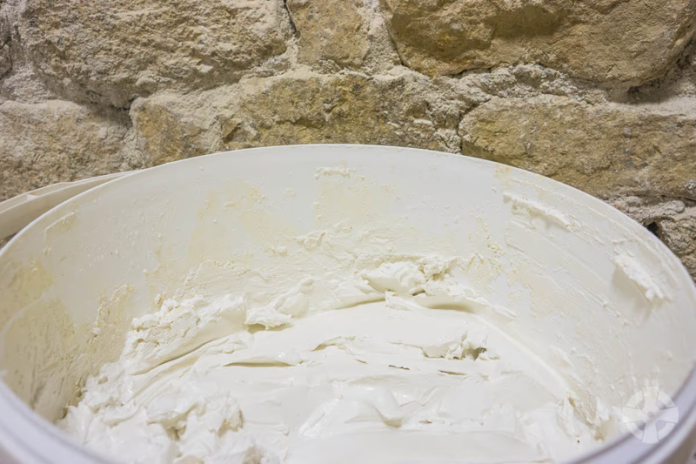Lime putty and lime mortar are two distinctive materials used extensively in the construction industry. Both have unique properties and applications that make them essential for certain types of construction projects.
Understanding the differences between these two materials is crucial for architects, builders, and DIY enthusiasts alike, but if you don’t have a technical background, it can be challenging to understand the nuances between them.
So – in this handy guide, we will discuss the key differences between lime putty and lime mortar and outline where they should be used. Let’s dive in!
Lime Putty vs Lime Mortar 101
What is Lime Putty?
Lime putty, also known as non-hydraulic lime, is the simplest form of lime for building, derived from burning pure limestone without any additives. It is then slaked with an excess of water to form a putty.
Lime putty hardens slowly through a process called carbonation, essentially the reverse of the original burning process, absorbing carbon dioxide from the atmosphere and returning to its original state of calcium carbonate or limestone.
This slow setting process results in a flexible and breathable material which is ideal for older buildings where movement or damp could be problematic.
What is Lime Mortar?
Lime mortar, on the other hand, is a mixture of lime putty and aggregate, typically sand. The mixture creates a workable compound that can be used to bind bricks, stones, and other construction materials together.
Like lime putty, lime mortar hardens over time by absorbing carbon dioxide from the atmosphere. However, the addition of aggregate to the mixture means that lime mortar is generally harder and stronger than lime putty.
Lime mortar is also more water-resistant, making it suitable for use in areas where moisture could be an issue. It is commonly used in masonry restoration and conservation projects.
Lime Mortar vs Lime Putty: What’s the difference?
So, what exactly is the difference between lime putty and lime mortar? Overall, the main difference between lime putty and lime mortar lies in their composition and strength. Depending on the specific needs of a construction project, either one may be more suitable than the other.
Here are some other essential differences to consider:
- Composition: Lime putty is made purely from burnt limestone and water, while lime mortar includes sand or other aggregates in the mix.
- Strength: As mentioned earlier, lime mortar is generally stronger than lime putty due to the addition of aggregate. This makes it a more suitable option for load-bearing structures.
- Flexibility: While both materials have some degree of flexibility, lime putty is more pliable and breathable compared to lime mortar. This makes it an ideal choice for repairing or restoring historic buildings that need to accommodate movement or moisture.
- Applications: Lime putty is commonly used for traditional plastering and rendering, as well as in the production of lime washes. Lime mortar, on the other hand, is typically used for masonry work, such as jointing and pointing of bricks or stones.
All in all, while lime putty and lime mortar may seem similar at first glance, the subtle differences in their properties and applications mean they are suited to different types of construction projects. Understanding these differences and choosing the right product can be the key to a successful building or renovation project.
Where to Use Lime Putty and Lime Mortar
The use of lime putty and lime mortar largely depends on the nature of the construction project.
Lime putty is highly flexible and breathable, making it ideal for use in the restoration of traditional buildings where a softer, more flexible pointing is required. In contrast, lime mortar, due to its strength and durability, is typically used in new-build construction or renovation projects where a stronger, more robust mortar is required.
Industries where lime putty and lime mortar are commonly used include:
- Historic preservation: Lime putty is often used for the repair and restoration of historic buildings due to its compatibility with traditional construction materials.
- Conservation projects: Similarly, lime putty’s breathable properties make it suitable for use in conservation projects where moisture management is crucial.
- Masonry work: As mentioned earlier, lime mortar is commonly used for masonry work, including jointing and pointing of bricks or stones.
- Plastering and rendering: Lime putty is a popular choice for traditional plastering and rendering applications due to its flexibility, breathability, and compatibility with historic materials.
Lime Mortar & Putty vs other materials
Although there are many differences between these two products, they align on one key front: lime.
Lime products like lime putty and mortar have been used for centuries and they are often compared to other modern materials such as cement-based mortars. One of the main advantages of using lime putty and lime mortar is their compatibility with older construction materials, making them a better choice for historic preservation or conservation projects.
Additionally, these traditional materials are historically more environmentally friendly as they do not require high energy consumption for production, unlike cement-based materials.
Closing thoughts
Hopefully, this guide has helped you understand the key differences between lime putty and lime mortar. While both materials are created from limestone and harden through carbonation, their properties and applications differ significantly.
Whether you’re working on a traditional restoration project or a new-build construction, understanding these differences can help you make an informed decision about which product to use for your specific needs.
Lime Putty vs Mortar: FAQs
Is lime putty the same as lime mortar?
No, while both are made from limestone and harden through carbonation, they differ in composition and strength. Lime putty is softer and more pliable, while lime mortar is harder and stronger, making them suitable for different types and aspects of construction projects.
What do you use lime putty for?
Lime putty is commonly used for traditional plastering and rendering, as well as in the production of lime washes. Its flexibility and breathability make it ideal for use in restoration or conservation projects where compatibility with historic materials is essential.















